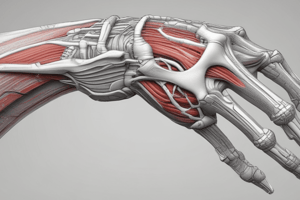Podcast
Questions and Answers
What is the primary function of the Acetabular Labrum in the hip joint?
What is the primary function of the Acetabular Labrum in the hip joint?
- To provide a smooth surface for the femoral head to move on
- To increase the movement of the hip joint
- To increase the concavity of the acetabulum (correct)
- To reduce the weight of the femur
What type of joint is formed by the union of the acetabulum and the head of the femur?
What type of joint is formed by the union of the acetabulum and the head of the femur?
- Synovial Hinge Joint
- Synovial Pivot Joint
- Diarthrodial Ball-and-Socket Joint (correct)
- Cartilaginous Joint
What is the shape of the femoral head?
What is the shape of the femoral head?
- A cylinder
- A complete sphere
- Two thirds of a sphere (correct)
- A hemisphere
What is the location of the femoral neck in relation to the femur?
What is the location of the femoral neck in relation to the femur?
How many angulations are made by the head and neck of the femur on the shaft?
How many angulations are made by the head and neck of the femur on the shaft?
In which plane does the angle of inclination occur?
In which plane does the angle of inclination occur?
What is the normal value of the angle of inclination in early infancy?
What is the normal value of the angle of inclination in early infancy?
What is the characteristic of Coxa vara?
What is the characteristic of Coxa vara?
What is the direction of the femoral head in Coxa valga?
What is the direction of the femoral head in Coxa valga?
What is the average angle of inclination in the normal adult?
What is the average angle of inclination in the normal adult?
Flashcards are hidden until you start studying
Study Notes
Lower Extremity Kinematics and Clinical Relevance
- Identify the kinematics of lower extremity joints, relate the structure to function (mobility and stability), and relate important biomechanical issues in clinical situations.
The Hip Joint
- The hip joint is formed by the union of the acetabulum of the pelvis and the head of the femur, forming a diarthrodial ball-and-socket joint with three degrees of freedom.
Structure of the Hip Joint
- Bony structure:
- Acetabulum: a cup-like, concave socket with an acetabular labrum, a ring of wedge-shaped fibrocartilage that deepens the socket, increases the concavity of the acetabulum, and grasps the head of the femur to maintain contact with the acetabulum.
- Femoral head: a convex component of the ball-and-socket configuration of the hip joint, forming two-thirds of a sphere.
- Femoral neck: a junction between the head and shaft of the femur, attached to the shaft of the femur between the greater trochanter and lesser trochanter.
Angulations of the Femur
- There are two angulations made by the head and neck of the femur on the shaft:
- Angle of inclination: occurs in the frontal plane, between the axis of the femoral neck and the axis of the femoral shaft.
- Angle of torsion: occurs in the transverse plane, between the axis of the femoral neck and the axis of the femoral condyles.
Angles of the Femur
- Angle of inclination:
- Normal value: approximately 150° in early infancy, decreasing to an average of 125° in normal adults, and somewhat smaller in women.
- Abnormal:
- Coxa valga: neck shaft angle is increased (> 135°), directing the femoral head more superiorly in the acetabulum.
- Coxa vara: neck shaft angle is decreased (< 125°).
Studying That Suits You
Use AI to generate personalized quizzes and flashcards to suit your learning preferences.




